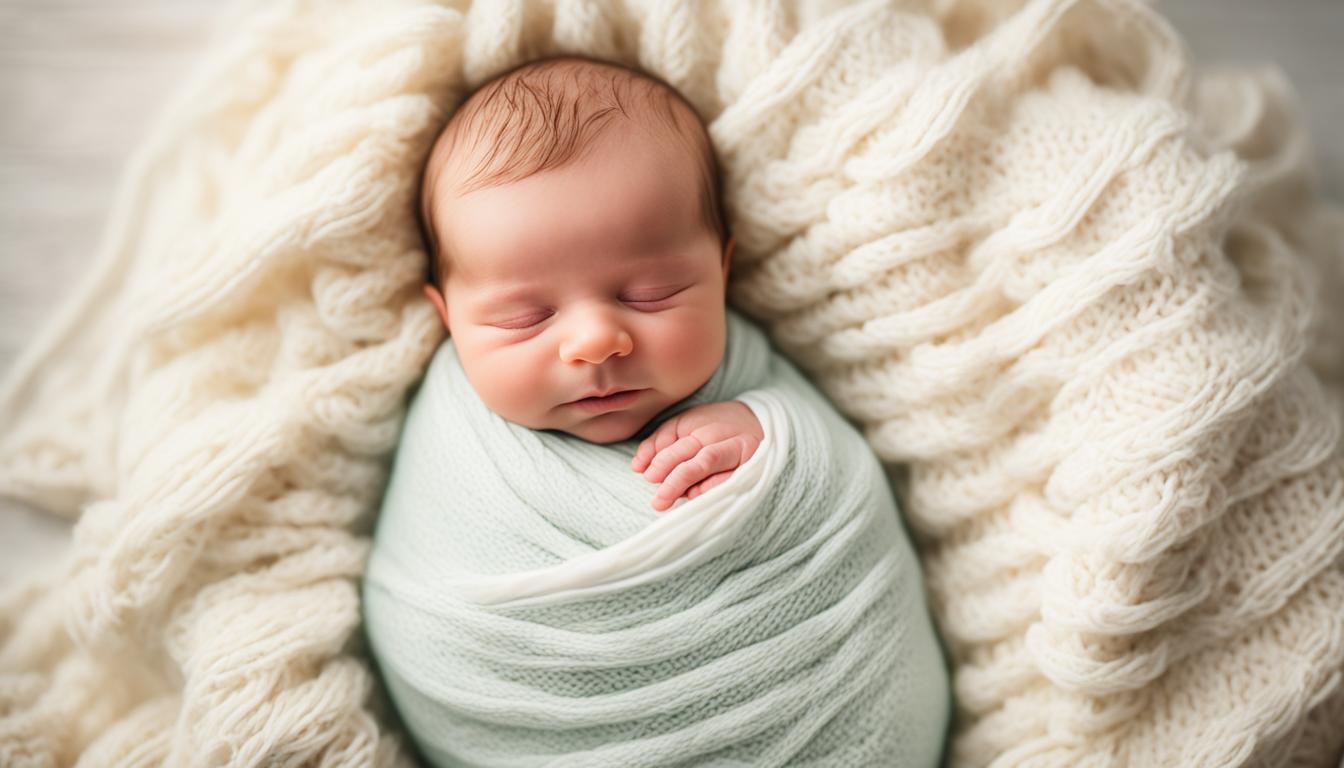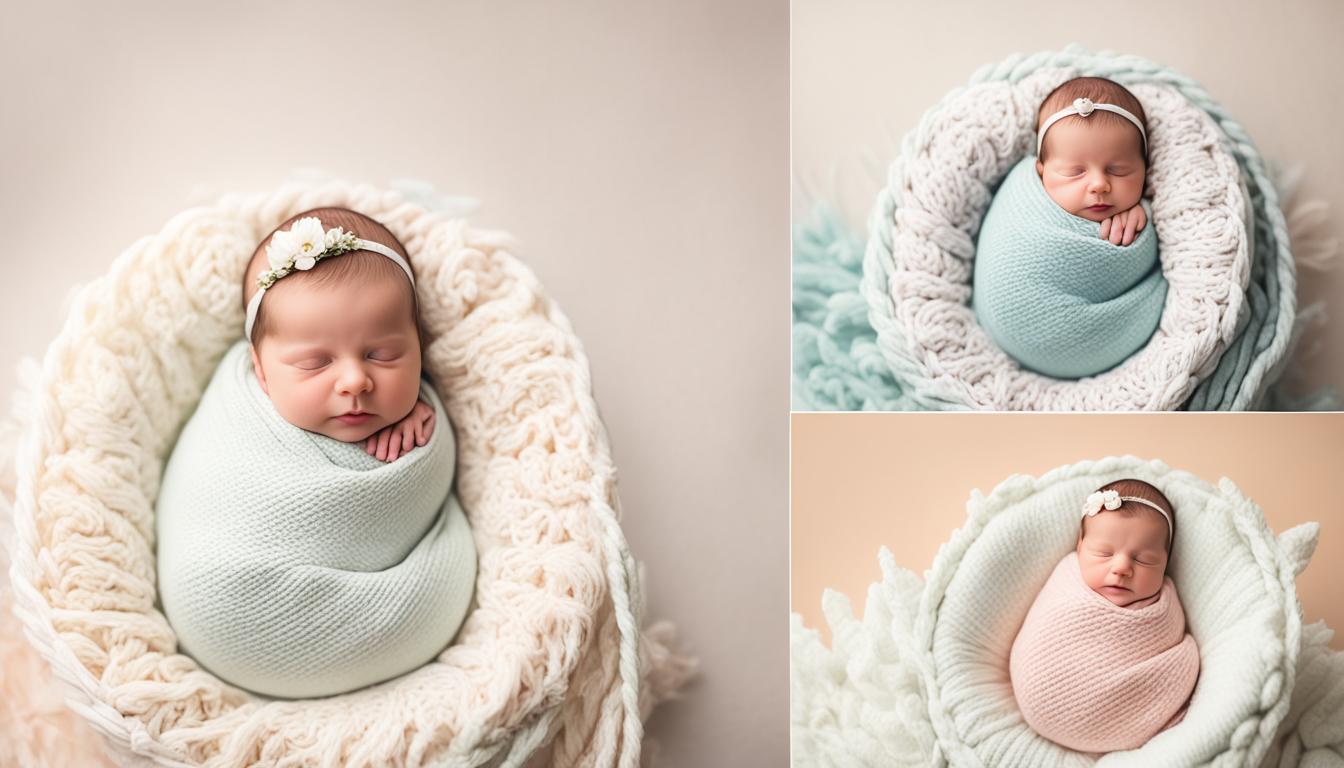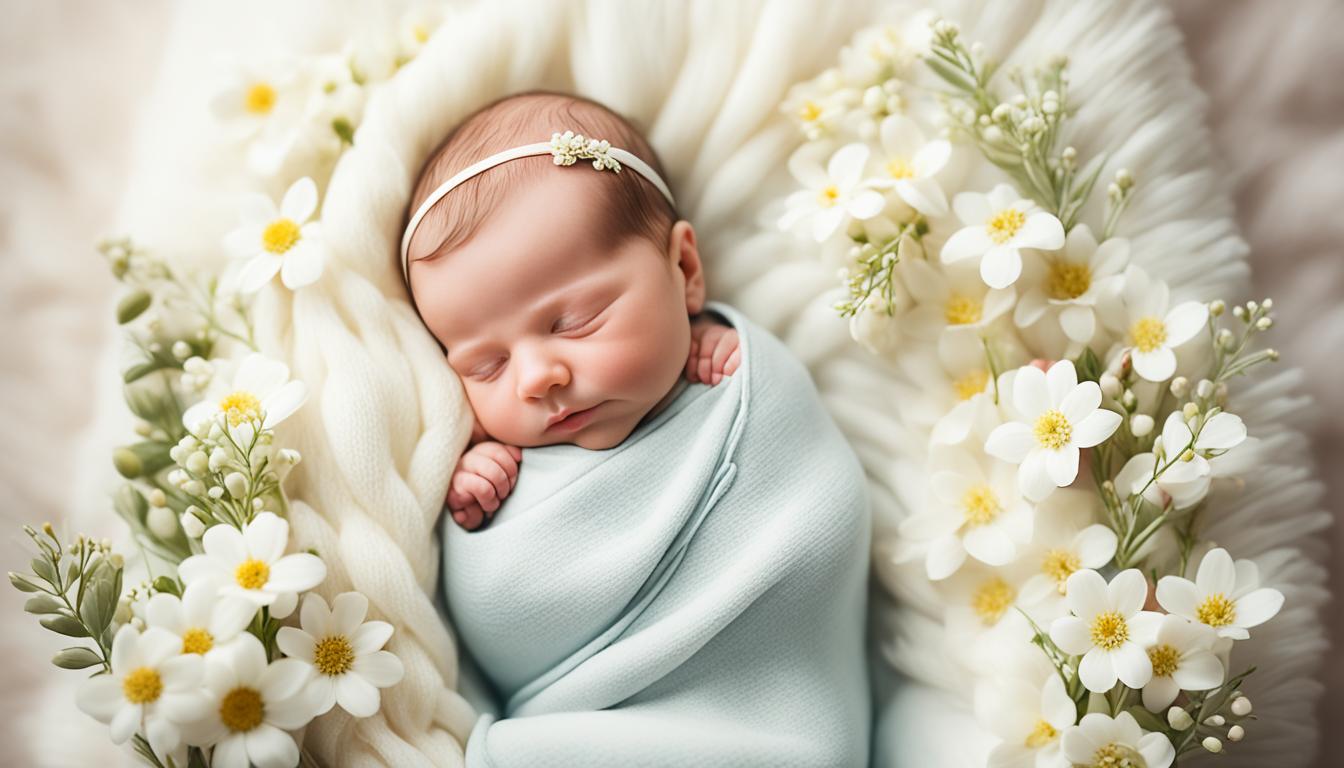Welcome to our article about natural light versus studio light in newborn photography! Capturing those precious moments of a newborn requires skillful lighting techniques, and knowing when to utilize natural light or studio lighting can significantly impact the outcome of your photos. In this article, we will explore the benefits of both natural light and studio light, as well as how combining the two can provide versatility in different lighting situations.
When it comes to newborn photography lighting, understanding the advantages of natural light and studio light is essential. As photographers, we strive to provide our clients with beautifully lit newborn portraits that capture the innocence and wonder of these early days. Let’s dive into the benefits of each lighting approach and how they can be harnessed to create stunning images.
Key Takeaways:
- Natural light and studio light both have their advantages in newborn photography.
- Natural light provides a soft and beautiful quality, but can be inconsistent depending on weather and time of day.
- Studio lighting offers control and consistency, allowing for faster shooting and editing.
- Combining natural light and studio light provides versatility to adapt to any lighting situation.
- Understanding light is crucial for newborn photographers to maximize its potential.
The Benefits of Natural Light in Newborn Photography
When it comes to capturing timeless and ethereal newborn portraits, natural light can be an invaluable tool for photographers. Its soft and beautiful quality enhances the delicate features of newborns, creating a gentle and dreamy look that many clients desire. Natural light newborn photography has a unique charm that is hard to replicate with artificial lighting.
One of the main advantages of natural light is its ability to create a relaxed and serene atmosphere during newborn sessions. Babies are naturally sensitive to their surroundings, and harsh studio lights can sometimes make them feel uncomfortable or overstimulated. By harnessing the power of natural light, photographers can create a calming environment that allows infants to rest peacefully, resulting in more natural and authentic photographs.
However, it’s important to note that natural light can also be inconsistent and unpredictable. Depending on the weather and time of day, the intensity and quality of natural light can vary significantly. Bright, sunny days can create harsh shadows and highlight unwanted imperfections, while overcast days provide a soft and diffused light that is ideal for newborn photography. Photographers must be adaptable and knowledgeable about the best lighting conditions to achieve optimal results.
Here are some essential tips for natural light newborn photography:
- Choose the right time of day: Early morning or late afternoon when the sun is lower in the sky can provide a more flattering and gentle light.
- Position the baby near a window: Utilize the soft, diffused light coming through a window to illuminate the newborn naturally.
- Use reflectors or white surfaces: These can help bounce and reflect light back onto the baby, reducing harsh shadows and creating a more even illumination.
- Experiment with different angles: Move around the baby and explore different angles to find the most flattering and captivating composition.
“Natural light has a magical quality that adds a touch of warmth and authenticity to newborn photos. Every time I capture a baby bathed in the soft glow of natural light, I know I’ve captured something truly special.” – Emily Stevens, Professional Newborn Photographer
Natural light is a versatile and invaluable tool in a newborn photographer’s arsenal. When paired with proper techniques and strategies, it can help create breathtaking and emotionally resonant images that families will treasure for a lifetime.
| Advantages of Natural Light | Disadvantages of Natural Light |
|---|---|
| Soft and beautiful quality | Inconsistent lighting conditions |
| Creates a gentle and dreamy look | Potential for harsh shadows |
| Relaxed and calming atmosphere for newborns | Dependent on weather and time of day |
| Natural and authentic photographs | Challenging to control the light intensity |
Harnessing the Power of Studio Lighting in Newborn Photography
Studio lighting is a powerful tool that offers newborn photographers the advantage of consistency and control over their lighting setup. With studio lights, we can create a predictable and controlled environment for newborn sessions, allowing for faster shooting and editing processes.
When it comes to newborn photography lighting setup, choosing the right equipment is crucial. Strobes or continuous lights are commonly used in studio setups, providing a reliable and powerful light source. These lights can be easily adjusted to achieve the desired intensity and can be positioned strategically to create the perfect lighting setup for each shot.

Modifiers such as umbrellas or softboxes can be used to diffuse and soften the light, ensuring a gentle and flattering illumination on the newborn. These modifiers help to minimize harsh shadows and create a soft, natural look in the images.
Studio lighting offers endless possibilities for creativity and versatility in newborn photography. By utilizing various lighting techniques, we can highlight the unique features of each newborn and create stunning portraits that will be cherished by families for years to come.
Studio lighting provides the advantage of consistency and control, letting us create a predictable and controlled lighting setup for newborn sessions.
| Pros | Cons |
|---|---|
| Consistent lighting conditions | Requires investment in equipment |
| Control over light intensity and positioning | Studio setup can be time-consuming |
| Faster shooting and editing process | May lack the softness and natural feel of natural light |
Studio lighting for baby photography offers a reliable and efficient way to capture stunning images of newborns. With proper knowledge and skills, photographers can maximize the potential of studio lighting and create captivating portraits that highlight the beauty of these precious little ones.
Combining Natural Light and Studio Light for Versatility
When it comes to newborn photography, the debate between natural light and studio light has been ongoing. However, the best approach often lies in combining both types of lighting to harness their unique advantages. By blending natural light and studio light, photographers can adapt to any lighting situation they may encounter during a session.
Having setups ready for both natural light and studio light allows photographers to seamlessly switch between them, ensuring they can achieve the desired results regardless of the conditions. This versatility is essential in newborn photography, where every moment counts and capturing the perfect shot is paramount.
Let’s explore the benefits of combining natural light and studio light:
“Natural light adds a soft and ethereal quality to newborn photos, bringing out their delicate features and creating a dreamy atmosphere. On the other hand, studio light provides control and consistency, allowing photographers to create a predictable and well-lit setup. By combining both, we can capture the best of both worlds and deliver stunning images for our clients.”
By blending natural light and studio light, photographers can achieve a wider spectrum of lighting effects, from gentle and soft to dynamic and dramatic. This versatility allows them to capture a variety of poses, moods, and expressions, allowing their creativity to shine.
| Natural Light Setup | Studio Light Setup |
|---|---|
| – Position the newborn near a large window where soft, diffused natural light is available. Use sheer curtains or blinds to control the intensity. | – Set up a continuous light source, such as a softbox or umbrella, at a 45-degree angle to create a flattering and even lighting on the newborn. |
| – Use reflectors or white foam boards to bounce and manipulate the natural light. This helps fill in shadows and add dimension to the image. | – Place a reflector or a second light source on the opposite side of the main light to reduce shadows and create a more pleasing and balanced lighting setup. |
By incorporating elements of both natural light and studio light, photographers can achieve versatile and visually striking results that meet the unique requirements of each newborn photography session. It’s important to experiment, practice, and adapt to different lighting situations to continually improve our skills as photographers.
The Importance of Understanding Light for Newborn Photography
As newborn photographers, our ability to capture incredible images hinges on our understanding of light. Knowing how to harness and manipulate both natural light and studio lighting is essential for creating stunning photographs that highlight the beauty of these precious moments.
When it comes to natural light, timing is everything. Understanding the best times of day for optimal lighting conditions can make a significant difference in the outcome of our newborn sessions. The soft and gentle quality of natural light can create a dreamy and ethereal look that captures the innocence and purity of newborns.
However, natural light can be unpredictable and challenging to work with. Factors such as weather conditions and time of day can dramatically affect the quality and intensity of the light. Overcast days are often preferred for natural light photography as they provide a soft and diffused illumination that beautifully enhances the newborn’s features.
On the other hand, studio lighting offers us control and consistency. By using artificial lighting sources such as strobes or continuous lights, we can create a reliable and predictable lighting setup. This allows us to have greater creative freedom and efficiency in our newborn sessions.
Studio lighting enables us to achieve consistent results regardless of external lighting conditions. With the right equipment and modifiers like umbrellas or softboxes, we can shape and control the light to accentuate the delicate features of the newborn. This control also extends to adjusting brightness, position, and direction, allowing us to create a variety of looks and styles.
However, mastering studio lighting requires understanding the technical aspects of lighting, such as light temperature, intensity, and angle. Experimenting with different lighting setups and modifiers can help us develop our artistic style and achieve the desired effects in our newborn photographs.
Ultimately, the key to outstanding newborn photography lies in combining our knowledge of natural light and studio lighting. By understanding their strengths and limitations, we can adapt to any lighting situation and create breathtaking images that truly capture the essence of these precious early moments.

“Understanding light is the cornerstone of great photography. It allows us to create mood, depth, and focus in our images. Whether using natural light or studio lighting, the ability to manipulate and control light is what sets apart exceptional newborn photographers.”
– Emily Davis, Professional Newborn Photographer
Conclusion
In conclusion, the debate between natural light and studio light in newborn photography is a matter of personal preference and the desired outcome. Both lighting setups have their own unique advantages that can enhance the beauty and appeal of newborn portraits.
Natural light offers a soft and ethereal quality that many photographers adore. It creates a gentle and dreamy atmosphere, perfect for capturing the innocence and delicacy of a newborn. However, it is important to consider the limitations of natural light, as it can be inconsistent due to weather conditions and time of day.
On the other hand, studio lighting provides photographers with ultimate control and consistency. With the right equipment and modifiers, they can create a predictable and controlled lighting setup, ensuring optimal results for every session. Studio lighting allows for faster shooting and editing, making it a preferred choice for many professionals.
Ultimately, the best approach is to be proficient in both natural light and studio light techniques. By mastering the art of manipulating light, photographers can maximize their creative potential and deliver stunning newborn photos. Understanding the characteristics and benefits of each lighting setup empowers photographers to make informed choices and adapt to any lighting situation they may encounter during a session. It’s not about choosing one over the other, but rather using both to achieve the desired results and create memorable newborn portraits that will be cherished for a lifetime.
FAQ
What are the benefits of natural light in newborn photography?
Natural light has a soft and beautiful quality that can create a gentle, dreamy look in newborn photos. It is preferred by many photographers for its aesthetic appeal.
Why is studio lighting important in newborn photography?
Studio lighting provides photographers with consistency and control. It allows for a predictable and controlled lighting setup, faster shooting, and editing. It is essential for creating professional newborn portraits.
Can I use both natural light and studio light in newborn photography?
Yes, many photographers choose to use a combination of both natural light and studio light. This versatility allows them to adapt to any lighting situation they may encounter during a session.
How can I harness the power of studio lighting in newborn photography?
To harness the power of studio lighting, it is important to choose the right equipment such as strobes or continuous lights. Understanding modifiers like umbrellas or softboxes is also crucial for achieving the desired look.
What is the importance of understanding light in newborn photography?
Understanding light is crucial in newborn photography as it allows photographers to maximize the potential of natural light and manipulate studio lighting to create stunning photos. This includes knowing the best times of day, angles, and modifiers to use.




